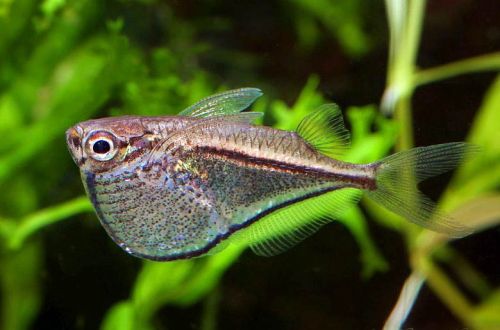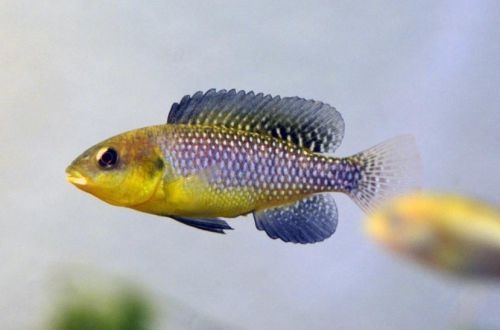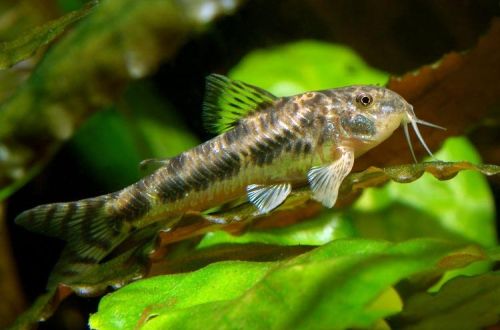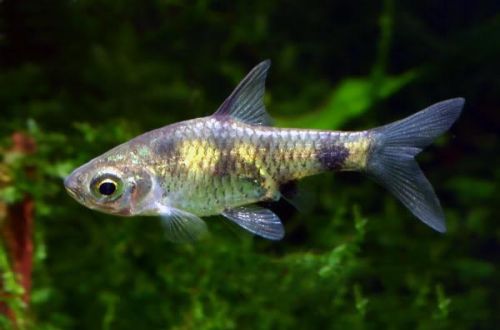
Carnegiella March
The warlock fish or Martha’s Carnegiella, scientific name Carnegiella marthae, belongs to the family Gasteropelecidae (Freshwater hatchets). The origin of the first name is unknown. As for the second, the fish is named after Margaret Carnegie, the wife of the researcher Eigenman, who discovered and described this species. Considered fairly easy to keep, but will probably not breed in the artificial aquarium environment.

Contents
Habitat
Comes from South America. It occurs in the upper basins of the Orinoco and Rio Negro rivers in what is now Venezuela, Colombia, and Brazil. The fish inhabits the so-called igapare regions (igarapé), which is translated from the Nhengatu language as “the path for canoes.” This is a small tributary or stream flowing through the tropical rainforest, hidden under the dense canopy of trees. The sandy substrate covers a thick layer of fallen leaves, branches, and other snags. The water has a rich brown or brown color due to the high concentration of humic acids released as a result of the decomposition of plant organic matter. The natural habitat is subject to seasonal changes associated with periods of drought and rain.
Brief information:
- The volume of the aquarium – from 50 liters.
- Temperature – 20-28°C
- Value pH — 4.0–7.0
- Water hardness – 1–10 dGH
- Substrate type – any
- Lighting – subdued or moderate
- Brackish water – no
- Water movement – light or moderate
- The size of the fish is about 3 cm.
- Food – any food that floats on the surface
- Temperament – peaceful
- Content – in a flock of at least 10 individuals
Description
It is a close relative of the Pygmy hatchetfish, but is slightly larger and does not have a translucent body. Adult individuals reach a length of about 3 cm. They have a typical shape for hatchet fish – a strongly convex and laterally compressed abdomen, resembling a ship’s keel or an ax head. The color is silver or grey. A black stripe stretches along the ridge and along the edge of the abdomen. There was no obvious sexual dimorphism. It is believed that females are larger and stockier than males. The fins are short and translucent. The pectorals resemble miniature wings. In connection with this, there was a myth for a long time that these fish are able to jump out of the water over long distances, and these fins allow them to maneuver in a fleeting flight. In 1995, this legend was refuted, of course they can jump, but only if they are scared
Food
Omnivorous species, accepts most of the popular food in the aquarium trade in dry, frozen and live form. An important condition is that the fish feeds exclusively at the surface, so the products should stay afloat for as long as possible.
Maintenance and care, arrangement of the aquarium
The optimal size of an aquarium for a flock of 10 fish starts from 50-60 liters. Martha’s Carnegie spends most of its time at the surface of the water, so it is necessary to provide enough free space for swimming and several areas with clusters of floating plants where they will gather. The design of the lower tier does not really matter.
Some breeders place dried leaves of some trees on the bottom, which not only give a more natural appearance to the aquarium, but also serve as a natural source of humic acids and other tannins, thereby bringing the composition of the water closer to that in which fish live in nature.
Successful long-term maintenance depends on water quality. It is important to prevent the accumulation of organic waste and maintain the temperature and hydrochemical parameters at an acceptable level. To this end, the aquarium is equipped with the necessary equipment, primarily a filtration system, and regular maintenance procedures are carried out: replacing part of the water (10–15% of the volume) with fresh water, timely removal of organic waste (remains of food, excrement), etc.
Behavior and Compatibility
Peaceful schooling fish, prefers to be in a group of at least 10 individuals. As neighbors, it is worth choosing the same peaceful species from among the haracins, plecostomus, apistogram cichlids and others.
Breeding / breeding
At the time of writing, there are no successful cases of breeding Carnegieella Martha in home aquaria. Deliveries are carried out mainly from commercial fish farms, hatcheries.
Fish diseases
A well-established biological system, a balanced diet and the absence of stressful situations (for example, being chased by aggressive fish) are the best guarantee of maintaining health. When the first signs of an illness appear, first of all, attention should be paid to these three factors, perhaps there was a deviation in one of them. As a rule, solving the problem leads to self-healing. However, if the immune system fails, you will have to resort to medical treatment. Read more about symptoms and treatments in the Aquarium Fish Diseases section.





